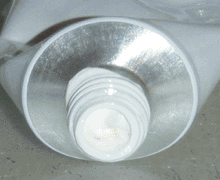

Like linseed oil, tung oil can be used to make paint, and the differences between these two paints reflect the differences in their base oils. Paint based on linseed oil is flexible and permeable, making it ideal for wood surfaces which grow and shrink with changes in humidity. On the other hand, paint based on tung oil is hard and waterproof, and as a result it appears to be ideal for coating metal. If raw tung oil is mulled with a suitable pigment, a paste results which can be thinned and brushed much like any other oil paint; however, care must be taken to avoid the characteristic wrinkling of the oil. This wrinkling is caused by surface-drying, which is promoted by sunlight and drying catalysts, and is inhibited by zinc oxide. Furthermore, the tendency to wrinkle is dependent on the thickness of the paint film; thin layers of paint can be applied freely under any conditions, but thick layers must dry indoors or otherwise contain some proportion of zinc oxide.
As a demonstration of this new coating, I made a white paint by mulling titanium dioxide into raw tung oil until it formed a stiff paste. I then thinned this paste to a fluid consistency with turpentine, which I have found to accelerate drying significantly compared to other solvents. The paint could be brushed in this state, but as a further demonstration I then thinned it to a milky consistency with acetone, and applied it to a piece of plate steel using an airbrush. The acetone is useful for this purpose since it allows the paint to pass through the brush, but evaporates rapidly and does not contribute to beading or runs. The steel was given three coats of paint; the first dried in a day indoors, and the second dried within an hour in direct sunlight, with no visible wrinkling. The paint was then wet-sanded with 800-grit paper, and the third coat was applied and allowed to cure thoroughly in the sun. Both the raw paint and the painted steel can be seen at the top of the page, with the airbrush included for contrast. Other than a few minor defects (airborne debris from painting outdoors), the surface has a uniform level of gloss, and cannot be scratched with a fingernail.
Overall, this appears to be a highly promising candidate for painting durable metal objects, such as tools, appliances, and vehicles. In particular, its hardness and the fact that it can be easily sanded and re-painted outdoors make it ideal for automotive applications, assuming its weather resistance is adequate. I look forward to using this paint in future projects, which will allow me to evaluate its long term wear characteristics under various conditions of use.
Without zinc oxide, this paint slowly becomes soft and rubbery over time, and will yellow severely if kept indoors. It appears that in general, oil paint requires a reactive, basic pigment to stabilize it against degradation. Where hardness and whiteness are needed, zinc oxide performs well; on the other hand, where permanent elasticity is needed (such as in canvas painting), white lead has been the classical choice.
EDIT: 7/19/2020Interestingly, if an inert pigment is used, this paint can be used as a heat-cure adhesive. Specifically, I found that a paint made with the minimum amount of oil and no thinners, using red iron oxide as the pigment, was able to bond metal, glass, and ceramic materials after baking for one hour at 250°C. Since this curing process does not require oxygen, this adhesive can be used in enclosed spaces much like epoxy, and is comparably waterproof and chemical-resistant. I intend to explore this in detail in a future article, in order to optimize the adhesion and cure time, as well as to investigate its UV-cure properties by using transparent fillers such as silica. Although the solidifying properties of tung oil have been troublesome in the past, it appears that I may be able to make use of them in the future.